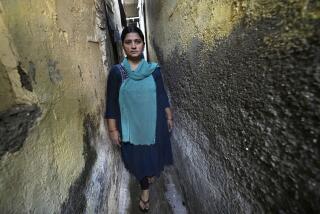At India bank, sex workers earn a little interest and self-esteem
- Share via
Reporting from Mumbai, India — Sima enters the small storefront in Kamathipura, Mumbai’s red-light district, and hands over some money she had hidden in her bra, then adjusts her fake Prada T-shirt. It was a national holiday the day before and business was good, so she’s deposited two days of earnings, about $66.
Along the wall, other women sit on cheap plastic chairs, chatting, in a bank with an unusual mandate: It serves only prostitutes.
“My dream is to save a lot, go back to my village, build a house,” says Sima, 25. “Well, maybe someday.”
A vast majority of the area’s 4,000 sex workers have accounts with as little as $1 at the 5-year-old financial institution, called Sangini, Hindi for “female friend.”
As Sangini sees it, sex workers with even a modest financial buffer are able to refuse clients wanting unprotected sex. And savings build confidence, providing the wherewithal to change professions if they choose.
Often, women will leave their passbooks here so husbands or pimps don’t discover and squander their earnings. Men can deposit but can’t withdraw funds without the woman’s permission, says Diane Cross, the charismatic social worker running the bank.
“If you’re saving, you’re not as desperate and can afford to make better decisions,” she says.
Said to be Asia’s largest red-light district, Kamathipura was first settled in 1795 under the British, gaining a reputation among soldiers and Indian customers for women whom human traffickers imported from as far away as Japan and Europe. Today it’s a seedy, albeit well-organized, network of streets in a predominantly Muslim neighborhood where women in encompassing burkas pass flurries of streetwalkers.
In addition to serving the women who come to the bank, three collection officers in red vests crisscross Kamathipura’s lanes handling deposits, withdrawals and new accounts.
Some of the women in the 14 narrow lanes specialize in working early, catering to overnight truckers, while others prefer handling the evening crowds. Most of the lanes are packed with four- and five-story buildings filled with 10-by-10-foot rooms, each with up to four beds. Male sex workers in the lanes are interspersed among the female workers, and Lane 1 has a heavy concentration of transgender people. Although Sangini’s clients are all women, it is considering signing up the other sex workers.
“We get lambasted by churches that we’re encouraging prostitution,” says Krishna Sarda, head of the India800 Foundation, a civic group funded by grants that’s underwriting Sangini’s $75,000 annual budget. “The idea you can stop this trade altogether is cloud-cuckoo-land. Our focus is on trying to stop the exploitation.”
There’s certainly enough of that around given Kamathipura’s many pimps, brothel owners, traffickers, petty thieves and loan sharks.
In a doorway near the bank, Rena calls to passing men. She’s wearing bright red lipstick and a tapered black dress reminiscent of a fish.
Having a savings account has been a godsend, she says. Normal banks require endless paperwork, eschew small deposits and look down on prostitutes, she says.
“Sangini’s kept every rupee safe,” money used to support her three children in Kolkata since her husband left, she said. “It’s really boosted my self-esteem.”
Although statistics are inexact, India has an estimated 2.5 million sex workers. Banks catering to them, an idea inspired by the micro-finance industry, also operate in Mysore and Kolkata, where the Usha Multipurpose Cooperative Society is among the nation’s oldest, started in 1995.
The Sangini bank offers 3% interest on regular and 5% on fixed deposits, money it deposits at 8% in a commercial bank. It uses the difference to pay rent, salaries and utilities. It recently stopped making loans after several weren’t repaid.
Sangini customer Simla says she came to India 20 years ago when a man in her impoverished Nepalese village said he’d marry her, then brought her to Mumbai and sold her to a brothel. She’s never gone back, given the social stigma.
“I’ve taken a wrong turn,” Simla says. “I worked for a civic group but that ended, so I’ve returned to sex work. I’ve got children to feed.”
Sangini is part financial institution, part group hug, part benefactor. A haggard prostitute who calls herself Pinky comes by to withdraw money. She’s 26 and HIV-positive, and has her 6-year-old daughter and newborn in tow. Prostitutes in Kamathipura say 70% to 90% of their customers use condoms, with many willing to pay more not to use one. An estimated 2.3 million people in India are HIV-positive.
Public hospitals dispense free anti-retroviral drugs and follow-up care. But Pinky’s baby wasn’t born in a hospital and doesn’t qualify for baby formula. So bank staffers spend from their own pockets to buy her food.
“It’s difficult to turn tricks with kids,” Pinky says, and earnings have declined as her looks have slipped. Bank employees say she makes few deposits and takes many withdrawals these days.
Prostitution in India is essentially legal, although solicitation, pimping and brothels aren’t.
“They criminalize everything around you without criminalizing you,” says Aditya Bondyopadhyay, a lawyer and activist.
When police arrest women in raids, or they’re suddenly hospitalized, the bank delivers funds to them.
In addition to the opposition to the bank’s activities on moral grounds, some Indians criticize its premise.
“The idea of saving is good since it reduces dependence on brothels,” says Ruchira Gupta, founder of Apne Aap Women Worldwide, an advocacy group. “But having their own bank is wrong because it ghettoizes them further. They should have access to all society’s normal bank services.”
At Sangini, Sima tucks away her passbook and heads back to work, pleased that her account is growing.
“The gods only know how long it’ll take me to buy a house,” she says. “But who knows. Maybe someday my balance will hit a million.”
Tanvi Sharma of The Times’ New Delhi bureau contributed to this report.
More to Read
Sign up for Essential California
The most important California stories and recommendations in your inbox every morning.
You may occasionally receive promotional content from the Los Angeles Times.













